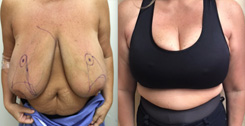Recovery After Breast Reduction
Posted On: September 20, 2011 Author: The Office of Dr. Stuart Linder Posted In: Uncategorized
Dr. Linder very much enjoys the challenge of breast reduction surgery and performs reductions weekly. Breast reduction patients do extraordinarily well. Removing a significant amount of tissue from the breasts will enhance the patient emotionally and physically. Recovery after a breast reduction, usually requires certain steps. In Dr. Linder’s practice, the patients are either kept in an aftercare facility if they live a distance away or they often will be sent home with family members to take care of them overnight. If a patient undergoes a massive gigantomastic breast reduction, these will normally be performed in a hospital setting such as Cedars-Sinai Medical Center with a 23-hour overnight stay, usually approved by the insurance prior to the operation. Patients who are having anywhere between 500 and 1000 grams of breast reduction per side normally do not require hospitalization.

Dr. Linder’s patients will have Jackson-Pratt drains placed for over 24 to 48 hours in order to remove fluid blood that may form around the inferior pedicle in order to prevent necrosis or problems with blood supply to the nipple areolar complex. We want to decompress the space around the pedicle that was created during the surgery, therefore, a 7 or 10 mm Jackson-Pratt drain will be placed for a minimum of 24 hours. Once the patients have left the recovery room, one-hour minimum in recovery by Federal law, they are asked to return the next morning at a set time. Once they return, the Bias dressings and the Jackson-Pratt drains will be removed. Brand new 4×4 gauze is placed and an athletic brassiere is then placed with the patient. The patients are asked not to remove any of these dressings or bras for the next seven days.
They will be maintained on antibiotics, which is usually 750 mg of Keflex twice a day for one week and Vicodin ES p.r.n. pain, Zofran 5 mg ODT p.r.n. nausea and vomiting. Flexeril is usually not given because there is no submuscular dissection. Patients will be seen seven days later. During the first seven days, the patients will be asked to maintain their back and head elevated at 30 degrees in a bed or recliner as well as to keep the incisions dry and to maintain all dressings without changing them for seven days. If there is any oozing, they are asked to reinforce that with dressings. However, if there is significant oozing, the patients are required to immediately see Dr. Linder.
Your surgeon should be on-call 24 hours a day, 365 days a year for emergencies at any time and should have a Medicare State Licensed Hospital for emergencies in case the patient needs to be taken back to the hospital for bleeding or infection. This is an absolute must. The patients will then return seven days later, dressings are removed and a new sports bra or athletic brassiere will be placed with the patient and the dressings will be changed by the patient for the next seven days two to three times daily.
Normally, the patients are off antibiotics and Vicodin and Tylenol can now be used for pain relief. We do not allow Advil, aspirin, Motrin, Excedrin, Ibuprofen or any aspirin-like products for the first three weeks. Sutures are removed usually on day 14 to 17 and the patients can then shower 48 hours later. Subsequently, the patients will use Kelo-cote twice a day, silicone gel spray to the incisions twice a day, once all sutures are removed. This helps to beautify the scar, reducing hyperpigmentation, keloiding, wide-spread scarring, the telangiectatic blood vessels that can be seen in the pink immature scarring.
Patients will follow up two weeks later, now at four weeks, and again at eight weeks where normally the patients are ready for postoperative photography. Pictures are taken, lateral oblique and frontal views. At this time the patients may now exercise, aerobic and anaerobic, can wear underwire bras (usually by 4-5 weeks) and should wear athletic brassieres at night to maintain position of the breasts and to prevent recurrent gravitational descent.
To schedule your consultation with Dr. Linder or learn more about breast reduction, call our office at 310-275-4513 or fill out our online contact form today.